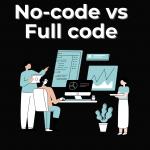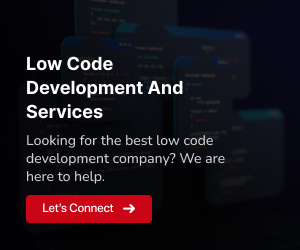In the ever-evolving landscape of mobile app development, low-code platforms have emerged as transformative tools for developers. These platforms offer a streamlined approach to creating mobile applications by significantly reducing the need for manual coding. With their user-friendly interfaces and pre-built components, low-code platforms empower developers to rapidly design, develop, and deploy mobile apps, cutting down development time and costs.
Low-code platforms cater to both seasoned developers and newcomers, providing a range of features and functionalities to suit various project requirements. By abstracting technical complexities and automating repetitive tasks, these platforms allow developers to focus on innovation and user experience. With their potential to boost productivity and accelerate project delivery, low-code platforms are shaping the future of mobile app development, making it more accessible and efficient for developers of all skill levels.
Benefits of using Low Code Platform
Low-code platforms offer substantial advantages for mobile app developers. They excel in expediting app development through pre-built templates and user-friendly interfaces, dramatically reducing time-to-market and the need for extensive coding expertise. These platforms also encourage collaboration among diverse stakeholders, enhancing cross-functional teamwork and decision-making.
From a financial standpoint, low-code platforms prove cost-effective by minimizing the requirement for large development teams, resulting in substantial savings for organizations. Furthermore, they empower rapid prototyping and iterative development, fostering quicker feedback loops and better user engagement.
Scalability is another key benefit; low-code apps can seamlessly expand in response to growing user demands. Additionally, these platforms enhance agility and innovation, allowing developers to swiftly adapt to evolving market trends and changing user preferences. This ensures that mobile applications remain competitive and aligned with current market dynamics. In conclusion, the advantages of low-code platforms make them a valuable tool for mobile app developers aiming to create high-quality applications efficiently and cost-effectively.
Downsides of using low-code
Low-code development in mobile app development offers numerous benefits, but it also presents significant downsides. One of its notable drawbacks is the trade-off between simplicity and customization. Low-code platforms excel in simplifying app development through pre-built components, but this convenience often limits the ability to create highly customized or specialized apps. As projects scale in complexity, low-code platforms may struggle to handle the demands of large, intricate applications or those requiring high performance, potentially necessitating a shift to traditional development methods.
Vendor lock-in is another concern as many low-code platforms are proprietary, potentially hindering future migration to alternative solutions. Security is paramount, as the abstraction of technical complexities in low-code development can inadvertently introduce vulnerabilities if not adequately tested and secured. Maintenance can become intricate as low-code applications evolve, demanding extensive updates and management, particularly if the original developers are no longer available. These downsides underscore the importance of carefully assessing low-code suitability for specific projects and considering its long-term implications.
Top Low Code Platforms in 2023
- GeekyAnts
- Airtable
- Zoho Creator
- OutSystems
- Backendless
- AppyPie
GeekyAnts
Geekyants is a versatile low-code platform catering to mobile app development, offering a range of benefits. With its user-friendly interface and pre-built components, it streamlines app creation, significantly reducing development time. This empowers developers to design apps quickly, making it ideal for prototyping and fast project iterations.
One of Geekyants’ strengths is its scalability. It can handle both small and large-scale applications, adapting as projects grow. However, while it simplifies development, it might limit customizability for complex, specialized needs.
Geekyants ensures security is a top priority, providing a secure environment for app development and reducing vulnerability risks. Vendor lock-in is a consideration, as organizations may rely heavily on the platform’s ecosystem. Maintenance is streamlined thanks to automatic updates and ongoing support, even as applications evolve. In summary, Geekyants is a robust low-code platform suitable for various mobile app development needs. It balances ease of use, scalability, security, and maintenance, making it a valuable tool for developers looking to accelerate their app creation processes.
Airtable
Airtable serves as a robust low-code platform for mobile app development, offering numerous benefits to developers. With its user-friendly interface, pre-built templates, and drag-and-drop functionality, Airtable simplifies the app creation process, allowing developers to build and deploy mobile applications quickly and efficiently, even with minimal coding expertise.
One of Airtable’s notable strengths is its adaptability. It caters to a wide range of use cases, from basic task tracking to intricate, data-driven applications. However, this flexibility may come at the cost of limited customization for highly specialized app requirements.
Airtable prioritizes data security, incorporating robust access controls and encryption measures to protect sensitive information. Nevertheless, like many low-code platforms, users should be mindful of potential vendor lock-ins, which can make transitioning to other solutions challenging. The platform’s automated updates and support also streamline maintenance, making it easier for developers to manage evolving apps. In summary, Airtable is a well-rounded low-code platform suitable for diverse mobile app development projects. Its user-friendliness, versatility, data security features, and maintenance support make it a valuable resource for developers seeking efficient app development solutions.
Zoho Creator
Zoho Creator shines as an efficient low-code platform for mobile app development, offering a versatile toolbox for streamlining the creation process. With its intuitive interface and drag-and-drop capabilities, Zoho Creator caters to developers of all skill levels, enabling them to design and deploy mobile apps effortlessly.
One of its notable strengths lies in its adaptability. Zoho Creator accommodates a wide range of use cases, from straightforward task management apps to intricate, data-centric solutions. However, this adaptability can sometimes limit customization for highly specialized applications.
Data security takes precedence on Zoho Creator’s platform, incorporating robust access controls and encryption measures to protect sensitive information. Nevertheless, like many low-code platforms, users should be cautious of potential vendor lock-in, which could complicate transitioning to other solutions. The platform’s automated updates and comprehensive support further simplify maintenance, allowing developers to efficiently manage and enhance their mobile apps as needed. In summary, Zoho Creator offers an efficient, adaptable low-code platform suitable for a broad spectrum of mobile app development projects. Its accessibility, versatility, data security features, and maintenance support make it a valuable resource for developers looking to expedite app development.
OutSystems
OutSystems is a prominent player in the realm of low-code platforms for mobile app development. It empowers developers to craft robust and scalable applications quickly and efficiently. With its user-friendly visual interface, OutSystems enables both seasoned developers and newcomers to design, build, and deploy mobile apps with minimal coding.
OutSystems boasts an extensive library of pre-built templates, components, and integrations, expediting the development process and reducing time-to-market. Its compatibility with various technologies and platforms ensures that apps work seamlessly across different devices and operating systems. However, OutSystems may have limitations when it comes to highly specialized or intricate app requirements that demand traditional coding approaches. Vendor lock-in is another consideration, as transitioning away from OutSystems can be complex after significant investment. In summary, OutSystems offers a robust and efficient low-code platform for mobile app development, prioritizing speed, accessibility, and a diverse set of features. It is a valuable tool for developers aiming to create high-quality mobile apps quickly.
Backendless
Backendless is a versatile low-code platform for mobile app development that simplifies the process of building powerful, scalable applications. With Backendless, developers can create both frontend and backend components with minimal coding, reducing development time and effort.
One of Backendless’s key strengths is its flexibility. It allows developers to customize their app’s logic and data structures, making it suitable for a wide range of applications, from simple mobile apps to complex, enterprise-level solutions. The platform offers a visual development environment and a vast library of pre-built templates and functions, streamlining the development process.
Additionally, Backendless provides robust backend services, including databases, APIs, user management, and cloud hosting, making it a comprehensive solution for end-to-end app development.
However, as with any low-code platform, there are limitations. Highly specialized or unique app requirements may require custom coding beyond Backendless’s capabilities. Vendor lock-in is also a consideration, as transitioning away from the platform may pose challenges. In summary, Backendless is an adaptable low-code platform that empowers developers to create a wide range of mobile apps efficiently. Its flexibility and comprehensive backend services make it a valuable tool for various development projects.
AppyPie
Appy Pie is a notable player in the low-code platform arena, especially in the realm of mobile app development. It stands out for its user-friendly approach, simplifying app creation for individuals and businesses with diverse skill sets. What sets Appy Pie apart is its drag-and-drop interface and an extensive library of pre-built components, making app development accessible even to those without advanced coding skills.
One of Appy Pie’s primary strengths lies in its ability to expedite the development process. Users can visually design and customize their apps, which is ideal for rapid prototyping and smaller to medium-sized projects. Additionally, Appy Pie offers cross-platform compatibility, allowing users to create apps for both Android and iOS devices simultaneously.
While Appy Pie’s simplicity is an advantage, it can be a limitation for complex or highly specialized projects. Scaling up may also pose challenges. Despite these considerations, Appy Pie is an excellent choice for individuals and businesses looking to quickly and cost-effectively develop mobile apps. Its intuitive interface and cross-platform capabilities make it a valuable asset in the low-code development landscape.
Embrace Efficiency and Innovation: Explore the Best Low-Code Platforms for US Mobile App Development Today!
In conclusion, low-code platforms are transforming mobile app development for US developers. From user-friendly options like Appy Pie to powerful solutions like OutSystems, these platforms enhance innovation and efficiency. They democratize app development, enabling both experts and newcomers to create apps swiftly and cost-effectively. With reduced development time and a focus on user experience, low-code platforms empower developers to tackle projects of all scales, from small apps to enterprise solutions. Embracing low-code development positions US developers at the forefront of the industry, fostering innovation and collaboration. These platforms catalyze the transformation of ideas into functional, user-centric mobile apps, offering a path to success in the dynamic world of app development.



















